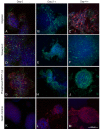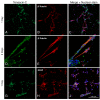Glypican-1, phosphacan/receptor protein-tyrosine phosphatase-ζ/β and its ligand, tenascin-C, are expressed by neural stem cells and neural cells derived from embryonic stem cells
- PMID: 20689858
- PMCID: PMC2914431
- DOI: 10.1042/AN20100001
Glypican-1, phosphacan/receptor protein-tyrosine phosphatase-ζ/β and its ligand, tenascin-C, are expressed by neural stem cells and neural cells derived from embryonic stem cells
Abstract
The heparan sulfate proteoglycan glypican-1, the chondroitin sulfate proteoglycan phosphacan/RPTP (receptor protein-tyrosine phosphatase)-zeta/beta and the extracellular matrix protein tenascin-C were all found to be expressed by neural stem cells and by neural cells derived from them. Expression of proteoglycans and tenascin-C increased after retinoic acid induction of SSEA1-positive ES (embryonic stem) cells to nestin-positive neural stem cells, and after neural differentiation, proteoglycans and tenascin-C are expressed by both neurons and astrocytes, where they surround cell bodies and processes and in certain cases show distinctive expression patterns. With the exception of tenascin-C (whose expression may decrease somewhat), expression levels do not change noticeably during the following 2 weeks in culture. The significant expression, by neural stem cells and neurons and astrocytes derived from them, of two major heparan sulfate and chondroitin sulfate proteoglycans of nervous tissue and of tenascin-C, a high-affinity ligand of phosphacan/RPTP-zeta/beta, indicates that an understanding of their specific functional roles in stem cell neurobiology will be important for the therapeutic application of this new technology in facilitating nervous tissue repair and regeneration.
Keywords: astrocyte; glypican; heparan sulfate; neuron; phosphacan; proteoglycan.
Figures




Similar articles
-
Interactions with tenascin and differential effects on cell adhesion of neurocan and phosphacan, two major chondroitin sulfate proteoglycans of nervous tissue.J Biol Chem. 1994 Apr 22;269(16):12142-6. J Biol Chem. 1994. PMID: 7512960
-
Complex-type asparagine-linked oligosaccharides on phosphacan and protein-tyrosine phosphatase-zeta/beta mediate their binding to neural cell adhesion molecules and tenascin.J Biol Chem. 1995 Oct 20;270(42):24650-3. doi: 10.1074/jbc.270.42.24650. J Biol Chem. 1995. PMID: 7559574
-
Interactions of the chondroitin sulfate proteoglycan phosphacan, the extracellular domain of a receptor-type protein tyrosine phosphatase, with neurons, glia, and neural cell adhesion molecules.J Cell Biol. 1994 Dec;127(6 Pt 1):1703-15. doi: 10.1083/jcb.127.6.1703. J Cell Biol. 1994. PMID: 7528221 Free PMC article.
-
DSD-1-Proteoglycan/Phosphacan and receptor protein tyrosine phosphatase-beta isoforms during development and regeneration of neural tissues.Adv Exp Med Biol. 2006;557:25-53. doi: 10.1007/0-387-30128-3_3. Adv Exp Med Biol. 2006. PMID: 16955703 Review.
-
Neurocan and phosphacan: two major nervous tissue-specific chondroitin sulfate proteoglycans.Perspect Dev Neurobiol. 1996;3(4):273-90. Perspect Dev Neurobiol. 1996. PMID: 9117260 Review.
Cited by
-
Matricellular protein tenascin C: Implications in glioma progression, gliomagenesis, and treatment.Front Oncol. 2022 Aug 12;12:971462. doi: 10.3389/fonc.2022.971462. eCollection 2022. Front Oncol. 2022. PMID: 36033448 Free PMC article. Review.
-
L-serine treatment may improve neurorestoration of rats after permanent focal cerebral ischemia potentially through improvement of neurorepair.PLoS One. 2014 Mar 26;9(3):e93405. doi: 10.1371/journal.pone.0093405. eCollection 2014. PLoS One. 2014. PMID: 24671106 Free PMC article.
-
Proteoglycans and their roles in brain cancer.FEBS J. 2013 May;280(10):2399-417. doi: 10.1111/febs.12109. Epub 2013 Feb 6. FEBS J. 2013. PMID: 23281850 Free PMC article. Review.
-
Roles of the PTP61F Gene in Regulating Energy Metabolism of Tribolium castaneum (Coleoptera: Tenebrionidae).Front Physiol. 2020 Aug 20;11:1071. doi: 10.3389/fphys.2020.01071. eCollection 2020. Front Physiol. 2020. PMID: 32973565 Free PMC article.
-
Spinal Progenitor-Laden Bridges Support Earlier Axon Regeneration Following Spinal Cord Injury.Tissue Eng Part A. 2018 Nov;24(21-22):1588-1602. doi: 10.1089/ten.TEA.2018.0053. Epub 2018 Oct 19. Tissue Eng Part A. 2018. PMID: 30215293 Free PMC article.
References
-
- Auerbach W, Dunmore JH, Fairchild-Huntress V, Fang Q, Auerbach AB, Huszar D, Joyner AL. Establishment and chimera analysis of 129/SvEv- and C57BL/6-derived mouse embryonic stem cell lines. BioTechniques. 2000;29:1024–1032. - PubMed
-
- Bain G, Yao M, Huettner J, Finley M, Gottlieb D. Neuronlike cells derived in culture from P19 embryonal carcinoma and embryonic stem cells. In: Banker G, Goslin K, editors. In Culturing Nerve Cells. MIT, Cambridge, MA: 1998. pp. 189–212.
-
- Beckett K, Franch-Marro X, Vincent JP. Glypican-mediated endocytosis of Hedgehog has opposite effects in flies and mice. Trends Cell Biol. 2008;18:360–363. - PubMed
-
- Bourdon MA, Coleman RE, Blasberg RG, Groothius DR, Bigner DD. Monoclonal antibody localization in subcutaneous and intracranial human glioma zenografts: paired-label and imaging analysis. Anticancer Res. 1985;4:133–140. - PubMed
-
- Braam SR, Denning C, van den Brink S, Kats P, Hochstenbach R, Passier R, Mummery CL. Improved genetic manipulation of human embryonic stem cells. Nat Methods. 2008;5:389–392. - PubMed
Publication types
MeSH terms
Substances
Grants and funding
LinkOut - more resources
Full Text Sources

